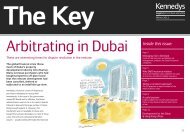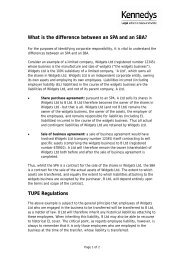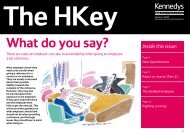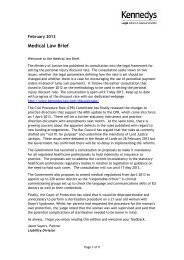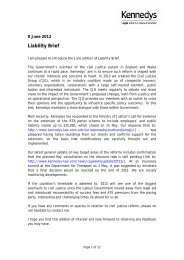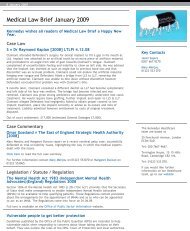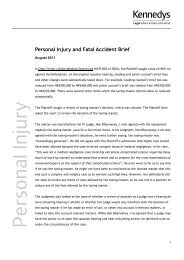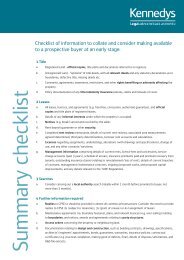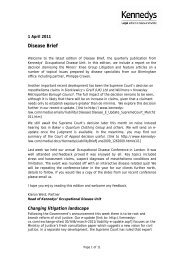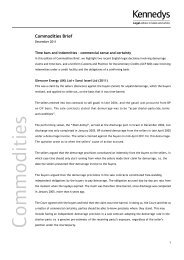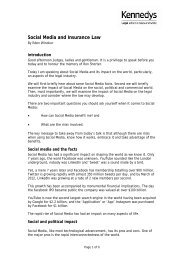Download Commodities Brief - August 2011 (PDF ... - Kennedys
Download Commodities Brief - August 2011 (PDF ... - Kennedys
Download Commodities Brief - August 2011 (PDF ... - Kennedys
Create successful ePaper yourself
Turn your PDF publications into a flip-book with our unique Google optimized e-Paper software.
<strong>Commodities</strong> <strong>Brief</strong><br />
<strong>August</strong> <strong>2011</strong><br />
Certificates of quality – final and binding?<br />
Quality and inspection certificates, as commercial documents, play an important role in international trade.<br />
Disputes can often arise as to the accuracy of the contents of certificates 1<br />
and whether or not one certificate<br />
or another is final and binding on the parties to the underlying contract. A recent case before the English<br />
Commercial Court has shown that certificate final clauses are not always what they might at first seem.<br />
RG Grain Trade LLP (UK) v Feed Factors International Ltd (<strong>2011</strong>)<br />
In the above case, the sellers (RG Grain) of 1,500 MT +/- 10% of animal feed supplement, Ukrainian origin<br />
sunflower expeller, appealed under s.69 of the Arbitration Act 1996 against a decision of the Board of Appeal<br />
of the Grain and Free Trade Association (GAFTA) awarding damages to the buyers (Feed Factors) and<br />
dismissing the sellers’ claim for the balance of the purchase price.<br />
The contract incorporated terms and conditions from GAFTA 119. Clause 5 of GAFTA 119 provided that the<br />
certificate of inspection at the time of loading into the carrying vessel would be final as to quality. The<br />
contract also incorporated terms and conditions from GAFTA Sampling Rules No. 124. Rule 4 provided that<br />
where such a certificate was to be final as to quality, that inspector would be solely responsible for taking<br />
samples, disapplying Rule 5 which provided that a buyer could request a further analysis.<br />
The contract further provided that quality and condition was to be tested by a GAFTA approved supervisor<br />
appointed by the sellers, with the buyers having the right to appoint their own GAFTA approved supervisor.<br />
Further analysis (if required) was to be carried out by an analytical chemist.<br />
When the cargo was being loaded, the buyers exercised their option to appoint their own surveyor and joint<br />
sampling was conducted. The sellers’ inspector certified that the cargo was in accordance with the contract<br />
specifications. However, the buyers’ analysis suggested that the cargo did not comply with the protein and<br />
fibre content specifications. The buyers sent samples to an analytical chemist (Salamon & Seaber) for analysis,<br />
who certified that the cargo did not comply with the protein and fibre content specifications. The buyers<br />
rejected the cargo, which was then sold to another buyer.<br />
1 See AIC Ltd v ITS Testing Services (UK) Ltd (2006) 1 Lloyd’s Rep. 1 - an inspection company had a duty to take reasonable<br />
care to ensure that any certificate it issued was accurate as to those matters on which it was instructed to report.<br />
1
Before the first-tier arbitrators, the sellers’ claim for the balance of the purchase price succeeded. On appeal,<br />
the Board found that the Salamon & Seaber analysis superseded the sellers’ certification and allowed the<br />
buyers’ appeal. The following questions came before the court:<br />
(1) Whether on a true construction of the contract, the certificates of quality and condition issued by the<br />
superintendent chosen by the sellers were final and binding; and<br />
(2) Whether the buyers were entitled to reject the documents and the goods despite the terms of Clause 5 of<br />
GAFTA 119.<br />
As to the first question, the court held that the Board had been correct to conclude that Salamon & Seaber’s<br />
analysis was final and binding. Quality as certified by the sellers would be final in circumstances where the<br />
buyers had not appointed their own supervisor. An alteration to the contractual regime was made when the<br />
buyers appointed their own supervisor. Sampling was then to be carried out jointly, in accordance with GAFTA<br />
124, which meant that, contrary to Rule 4, the sellers’ inspector would not be solely responsible for drawing<br />
samples. A further contractual alteration occurred when a second analysis was requested by the buyers.<br />
Although it was not expressly stated in the contract as the buyers’ right, the court held that it was clearly<br />
what was contemplated under the contract. If quality was final as certified by the sellers’ inspector, there<br />
would be no purpose in providing for a second sample. Hamblen J added:<br />
“…The existence of such a right is therefore inconsistent with a certificate final regime. This is further<br />
borne out by GAFTA 124 where a right to call for a “2 nd analysis” only arises in circumstances where<br />
there is no such regime, as Rule 4 makes clear.”<br />
It followed that when the buyers requested a second sample, the contract did not provide that the sellers’<br />
certification would be final. The second analysis carried out by Salamon & Seaber (at the request of the<br />
buyers) was final and binding.<br />
As to the second question, the court held that the Board had proceeded on the basis that there was a right of<br />
rejection for quality matters unless the contract provided otherwise. The Board’s approach involved “a clear<br />
error of law”. There was nothing in the Board’s reasons to suggest that it had addressed the issue of whether<br />
the fibre content provision should be properly regarded as a condition, as opposed to a warranty or an<br />
innominate term 2 . The Board assumed that the term was a condition unless there was a clear indication to<br />
the contrary. This was not the law. The court further held that the Board had erred in concluding that the<br />
2 Breach of which may or may not go to the root of the contract depending on the nature of the breach. See Hong Kong Fir<br />
Shipping Co. Ltd. v Kawasaki Kisen Kaisha Ltd., [1961] 2 Lloyd’s Rep. 478<br />
2
each of the fibre content provision gave rise to a right to reject and it had not addressed the relevant legal<br />
questions in reaching that conclusion. The buyers were not entitled automatically to reject the documents<br />
because of a statement in the quality final certificate that the goods contained 4.1 per cent impurities. The<br />
Board had erred in law in concluding that the buyers were entitled to reject the documents, and that this<br />
issue should be remitted to the Board for further consideration.<br />
Regulation: Dodd-Frank - one year on<br />
One year after the enactment of the Dodd-Frank Act, US policymakers have yet to detail many of the rules<br />
which will clarify the extent to which Wall Street giants and commodity markets will be regulated. Democrats<br />
and others argue that banks are still too big, the derivatives market lacks controls and transparency, and that<br />
the rule making process has been slow. Republican lawmakers and the financial industry say that regulators<br />
have gone too far with onerous demands which are hurting economic recovery.<br />
The coming months are expected to clarify new capital and liquidity standards, and the Volcker limits on<br />
proprietary trading. An initial draft of the Volcker rule is expected some time this summer, with a final rule<br />
due by October.<br />
On 21 July, the Commodity Futures Trading Commission (CFTC) Chairman, Gary Gensler, said that the CTFC<br />
could take up in September a long-anticipated rule designed to curb excessive speculation in the commodity<br />
markets. Traders have argued that curbs could increase price volatility by removing liquidity and driving<br />
business to markets overseas. The CFTC continues to take a tough stance on market manipulation and in May<br />
sued oil trader Arcadia Petroleum for manipulation. A former portfolio manager for Moore Capital<br />
Management agreed last week to pay the CTFC US$1 million to settle charges he attempted to manipulate<br />
prices of palladium and platinum futures contract on the NYMEX, by engaging in a trading practice known as<br />
“banging the close” 3 .<br />
Some believe that the CFTC may re-propose a rule to allow clearinghouses more time before they have to<br />
decide whether to accept and guarantee trades in the US$600 trillion swaps market. The new proposal would<br />
require decisions as soon as technologically possible and, according to the CFTC’s Chairman “The proposed<br />
rule promotes market participants’ access to central clearing, increases market transparency and supports<br />
market efficiency”. The CTFC has estimated that it will vote on at least 37 rules between July and October.<br />
According to joint recommendations published by the CTFC, the Federal Reserve and the Securities and<br />
Exchange Commission (SEC), regulators plan to increase cooperation on overseeing US clearinghouses.<br />
3 When a trader acquires a substantial position leading up to the closing period, and then offsets the position before the end<br />
of trading to try to manipulate closing prices.<br />
3
Regulators’ plans would see clearinghouse operators subject to an increased level of scrutiny as they prepare<br />
to handle more of the over-the-counter (OTC) derivatives market. Last week, the SEC was expected to<br />
increase its market oversight by adopting new rules to help track the activities of large traders. The<br />
large-trader reporting system 4 , and a proposed rule for a consolidated audit trail, could be finalised later this<br />
year.<br />
G20 leaders agreed in 2009 that to curb risks, derivatives traded OTC or privately between banks should be<br />
cleared centrally and reported to a repository by the end of 2012. Delays have also beset the rule making<br />
process in Europe. It has been reported that new EU derivatives rules are unlikely to be agreed until at least<br />
early autumn. Equally, France’s drive to get the world’s leading economies to toughen regulation on<br />
commodity markets appears to be losing traction as governments express concern that tighter trading rules<br />
may harm their financial interests.<br />
In other news<br />
According to the China Futures Association, commodity futures trading in China dropped 30 per cent in the<br />
first half as regulators curbed speculation and the central bank took steps to ease rising inflation.<br />
In July, gold prices rose to a record of more than US$1,600 per ounce, as US politicians failed to reach<br />
agreement to raise the government’s US$14.3 trillion borrowing limit. The risk of an unprecedented US debt<br />
default lingers on and Europe’s sovereign crisis escalated as Ireland joined Portugal and Greece as the third<br />
Euro-area nation to have its credit rating but to below investment grade.<br />
On the NY Comex and the London Metal Exchange (LME), copper futures for September delivery and for<br />
delivery in three months both fell, signifying that demand may be dwindling in China, the world’s largest<br />
metal user.<br />
Last week Bloomberg reported that China’s largest shipping companies are lobbying the government to block<br />
Vale SA’s plan to build a US$2.3 billion fleet of the world’s largest iron ore carriers. Zhang Shouguo, executive<br />
vice chairman of the China Shipowners Association, claims that “Vale is seeking to control the freight market<br />
as it has done with iron ore prices”. According to Clarkson Research Services Ltd, the global fleet of bulk<br />
carriers will expand 13 per cent this year, compared with the 4 per cent growth it forecasts for shipping<br />
commodities by sea. According to data compiled by Bloomberg, the cost of transporting iron ore to China<br />
from Brazil is now equal to 10 per cent of the value of the commodity used by steelmakers, compared with 64<br />
per cent in 2003.<br />
4 First proposed in April 2010. A brief period of volatile trading in May 2010, known as the “flash crash”, highlighted the<br />
need for faster and more detailed data.<br />
4
In June, Singapore said that it will set capital levels for local lenders 2 percentage points above the so-called<br />
Basle II rules to solidify the city’s reputation as a financial hub. In July, Malaysia-based Pheim Asset<br />
Management Sdn failed in its bid before the Singapore Court of Appeal to overturn Singapore’s first (civil) High<br />
Court decision on market manipulation. Singapore’s central bank, which has beefed up its financial<br />
misconduct rules the wake of the 2008 credit crisis, has said that it will not tolerate “window dressing” 5 by<br />
fund managers.<br />
Events and conferences<br />
<strong>Kennedys</strong> Breakfast Seminar<br />
Letters of Indemnity in international trade and shipping<br />
80 Raffles Place, #44-05 UOB Plaza 1, Singapore 048624<br />
10 <strong>August</strong> <strong>2011</strong>, 8:45am for a 9am start<br />
To register, please contact Faith Lee, T +65 6671 7400, f.lee@kennedys-law.com.sg<br />
Energy Risk Asia <strong>2011</strong><br />
Singapore<br />
29 September <strong>2011</strong><br />
Iain Sharp is participating in a panel discussion on the implementation of Dodd-Frank and changes to the<br />
regulation of global OTC markets at Energy Risk Asia <strong>2011</strong>. The conference, hosted by Energy Risk magazine,<br />
brings together energy professional from across the region to discuss trends and developments in regulations,<br />
hedging strategies, risk management techniques and commodities markets. www.energyriskasia.com<br />
For more information, please contact<br />
Iain Sharp – Partner<br />
<strong>Kennedys</strong><br />
80 Raffles Place<br />
#44-05 UOB Plaza 1<br />
Singapore 048624<br />
T +65 6671 7413<br />
E i.sharp@kennedys-law.com.sg<br />
www.kennedys-law.com.sg<br />
5 The manipulation of share prices so as to enhance the performance of funds under a fund manager’s charge.<br />
5



